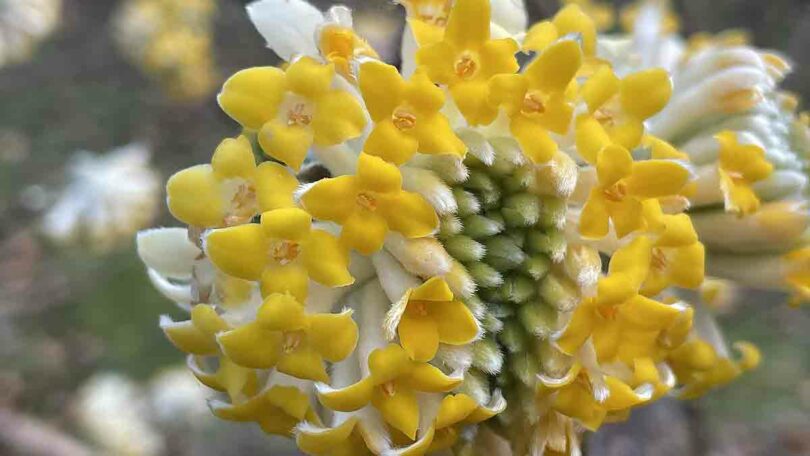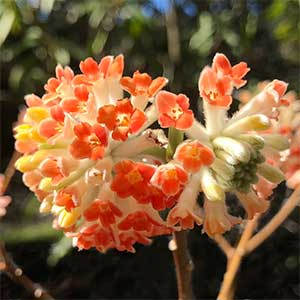Related to the daphne and with fragrant flowers Edgeworthia chrysantha is commonly called the Paper Bush. It is related to Daphne and the flower clusters do look similar.

The flowers form as terminal clusters, and this deciduous shrub flowers in late winter to spring.
The species itself has golden yellow flowers, and Edgeworthia chrysantha ‘Grandiflora’ has larger vflowers as the name suggests.
The cultivar ‘Red Dragon’ has red to Orange flowers and all varieties have the same growth habit.
Originally from the Himalayas, China and Japan where the plant is called ‘Mitsumata’ and interestingly the bark is used to make a type of handmade (Washi) paper in Japan this is called ‘Yuzen’ papers sometimes called ‘Chiyogami’ .

How to Grow Edgeworthia chrysantha
These are a plant that do require a little protection from very hot winds and cold winds. A sunny proceeded position works well.
The best time to plant edqworthis is in spring as soon as the weather warms little,
- Dig the soil over well before planting, removing weeds and adding some compost.
- Plant and water in with a liquid seaweed fertiliser.
- Mulch around the plant to maintain a cool moist root run.
- Provide moisture through dry summer periods as required.
Pruning Edgeworthia chrysantha
With a naturally neat and rounded growth habit this is a plant that requires very little to no pruning at all.
You can prune away any dead or damaged wood at any time, other than this, in an open position, it is just naturally a compact growing plant.
Propagation
There are 4 wys to propagte Edgworthia some easier than others.
- The easiest way to propagate Edgworthia is by removing new suckers from the base making sure you take some roots with the sucker.
- The Second Way is by Cuttings are best taken in summer.
Find a semi ripe cutting, so new growth that has hardened off a little.
Take your cutting using sharp secetaures, or a sharp knife.
Remove the foliage except for that on the top 1/4 to 1/3 of the stem.
Snip this foliage off rather than pulling it or rubbing it off.
Dip the lower part of the cutting in a rooting hormone (liquid or powder)
Plant the cutting in a humus rich propagating soil. A good quality potting soil is sometimes suitable.
The cutting should have at least 1/2 the stem below soil level.
Place the cutting in a mini greenhouse or cover with a plastic bag or bottle to maintain humidity.
Mist spray once a day.
After 6 weeks place the cutting in a cool protected position with good indirect light and maintain moisture. - You can try water propagation although we find with Edgeworthia, the success rate is very low using this method.
- You could also try propagation from seeds. If you can find them
Summary Information
- Botanical Name – Edgeworthia chrysantha (syn. Edgeworthia papyrifera)
- Common Name – Paper Bush
- Position – Full sun to afternoon shade.
- Soil – Humus rich moist and well drained.
- Height – To around 1.5 to 2 metres
- Spread – To around 1 metre.
- Flowers – Yellow, or Red to Orange.
- Flowering time – Late winter to spring.
- Frost tolerant – No
- Drought tolerant – No
